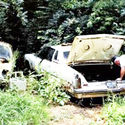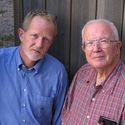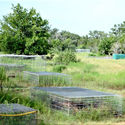Body Farms: tending corpses, not crops
November 4, 2020
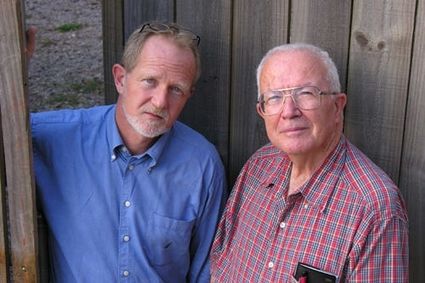
Jon Jefferson (left) and Dr. Bill Blass (right) write using the pen name Jefferson Bass. The pair has written about ten books, both fiction and non-fiction, about body farms-the forensic anthropological facilities where research about how human bodies decompose is done. Dr. Bass, a retired forensic anthropologist, created the first body farm at the University of Tennessee in 1972. There are now eight such facilities in the U.S.
My wife and I live in the Grande Villa in Chinook and there is a tradition there among residents to put their unwanted items "on the bench." Each floor has a bench by the elevator, the place to leave items no longer wanted or to pick up something that catches the eye. I call the benches "the Mall of America."
Recently I found a paperback titled "Cut to the Bone" by Jefferson Bass. I'd never heard of the author but from the title assumed it was a book about crime. Turns out the book was authored by a writing team-Jon Jefferson, a journalist, and Dr. Bill Bass, a retired forensic anthropologist and college professor. The two wrote several books based on research and criminal cases worked by Dr. Bass.
Dr. Bill Bass is credited with starting the first body farm in the U.S. Popularized in recent TV shows about crimes, body farms are facilities where scientists study how human corpses decompose and how environments affect decomposition. These studies yield information investigators use when examining human remains not suitable for an autopsy, to determine cause and time of death of victims. There are now eight body farms in the U.S. Here's some of what I learned about this unusual branch of science.
The development of forensic anthropological facilities (body farms)
Body farms were created with a twofold purpose: provide outdoor, climate-specific research and teaching facilities to advance forensic science and develop collections of documented skeletal samples. Research results help determine causes and times of death in human remains. Bodies used for research are donated much like to programs that train medical students. Once the research is completed involving the corpses, documented skeletal remains are kept for future reference. The first body farm was created Dr. Blass on a 2.5 acre plot at the University of Tennessee in 1972.
Built between 1972 and 2018, most body farms are in the southern part of the U.S.-two in Texas, one in Florida (for a subtropical environment) and one in western North Carolina (mountainous region). A few farms were established for more specific climate variations including a prairie/hill country site in southern Illinois, a high altitude plot in Colorado and a fairly recent site in the Upper Peninsula of Michigan to study extreme cold effects on decomposition.
All facilities have outdoor space for bodies to be studied while exposed to the elements and some have sophisticated research and teaching facilities as part of the farm. Most farms are about one acre in size, normally surrounded with privacy and security fencing. A body farm in Texas is a small part of a 4000 acre ranch used by the university to teach ranch management. The prairie site is on a third of an acre.
A typical body farm will add six to twelve bodies each year. Most cadavers are used for research between one and three years by which time soft body tissue is gone. The skeletal remains are then added to the locale's bone collection. Bodies are donated and are accepted with some restrictions-there must be some known medical history about the cadaver and corpses are not accepted where death was from certain communicable diseases. On every farm the corpses being studied in the open environment are protected by cages that allow for exposure to weather and insects but not to human or animal scavengers. Farms are usually surrounded with fencing to discourage pranksters or other tampering with the bodies.
Scientists first studied insects to learn how they affect the decomposition process. Learning the time when certain insects appear on a cadaver during composition was the early focus of many studies.
Then identifying how other factors affected decomposition, like temperature, moisture, even soil type affects composition, gave law enforcement more investigative tools. One body farm is focusing on how "clandestine postmortem treatment" affects decomposition-for example, how does a body in the trunk of a vehicle decompose compared to one in a shallow grave, etc.
Some interesting challenges faced by body farms
Well, the first challenge is what to call the facilities. The director of the prairie facility told a student reporter, "We don't farm or raise bodies. Body farm is a derogatory term and not a wrod those of us in the field actually use." Most facility names include some mention of "forensic anthropology" and use some catchy acronym, like FROST, FIRS, AFTER and FOREST to identify a site.
Readers may by thinking, "Do these facilities stink?" Yes, there is some odor and the fear of that often causes pushback when considering a site for a body farm. At the site in Knoxville at UT a group called SICK (Solutions for Concerns of Knoxvillians) protested at the proposed site. In another state a first site was rejected for fear scavenging birds (buzzards) drawn by the smell would interfere with nearby air traffic. In these and other cases the problems were solved and the sites function without undo community concerns.
Sometime things just go off the rails and scientists have to improvise. At the prairie site a groundskeeper on a riding lawnmower ran over a corpse hidden by high weeds. A researcher and their students used the incident to study the best way to find, recover and identify the severed body parts. A better way to control access to the site was also implemented. In case readers are wondering, none of the body farms offer tours.
The future role of forensic anthropological research
One thing is for sure, body farms will continue to add new plots for TV shows about criminal investigations. And novelists will figure more tactics to work body farms in to their books.
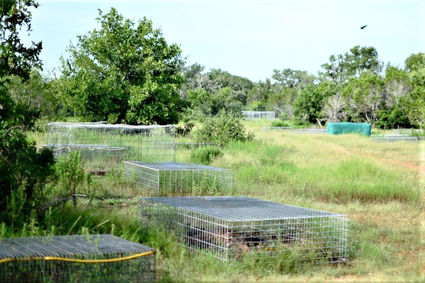
Some corpses at body farms are exposed to the elements to study how they decompose. For security from predators (human and animal) the corpses are surrounded with fences or cages. This photo is from a body farm in Texas. Most body farms study a cadaver for about three years, then classify and file the remaining skeletal bones for future reference.
Will body farms be the "new DNA" for law enforcement? Not likely. But there is a growing acceptance and use by investigators of the findings from research at body farms. That may encourage building more regional sites with additional climate-specific environments. Researchers at existing body farms are already broadening their research to include more environmental aspects that might be useful to investigators dealing with human remains. Body farms are a growing field...no pun intended.



